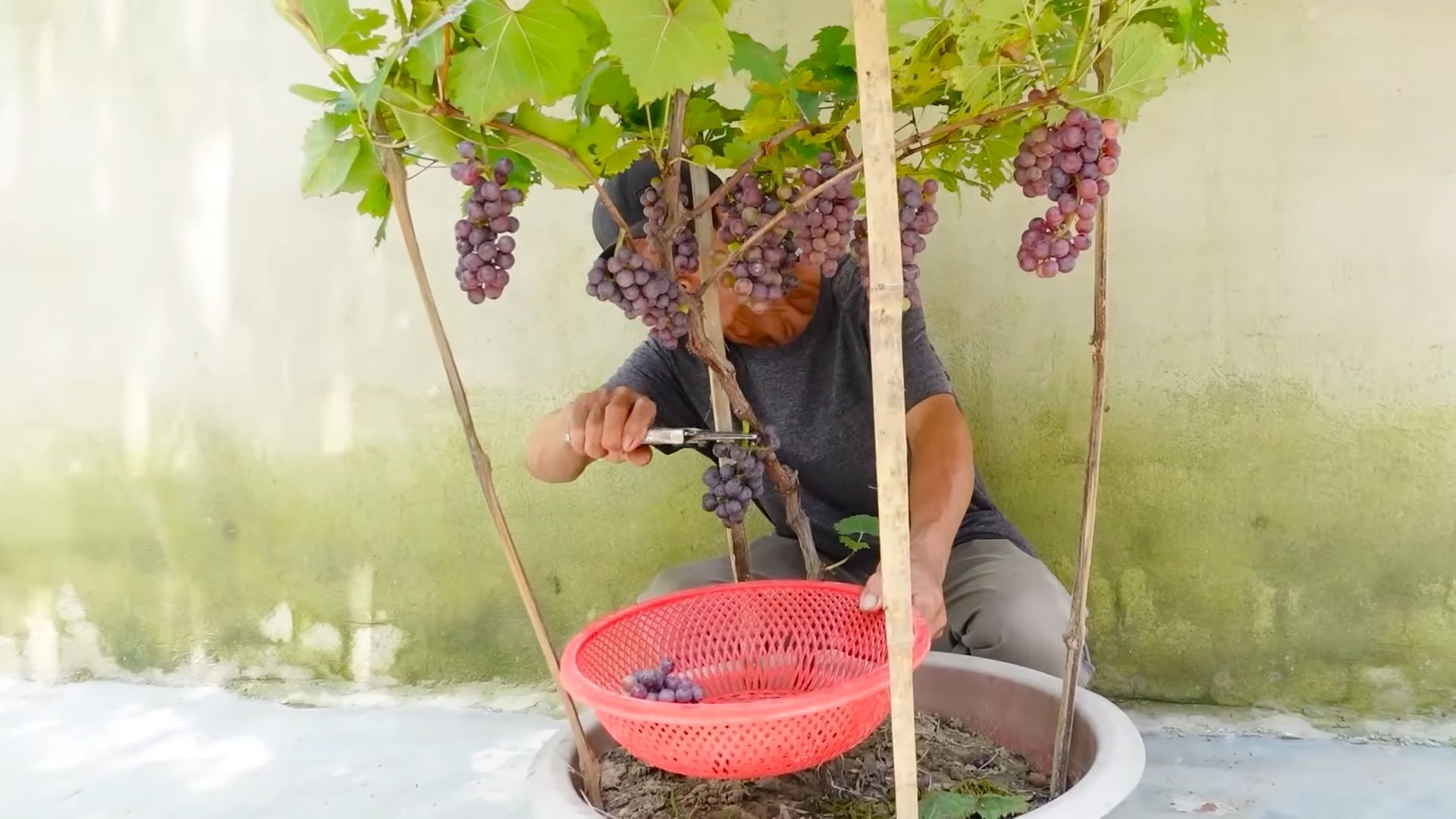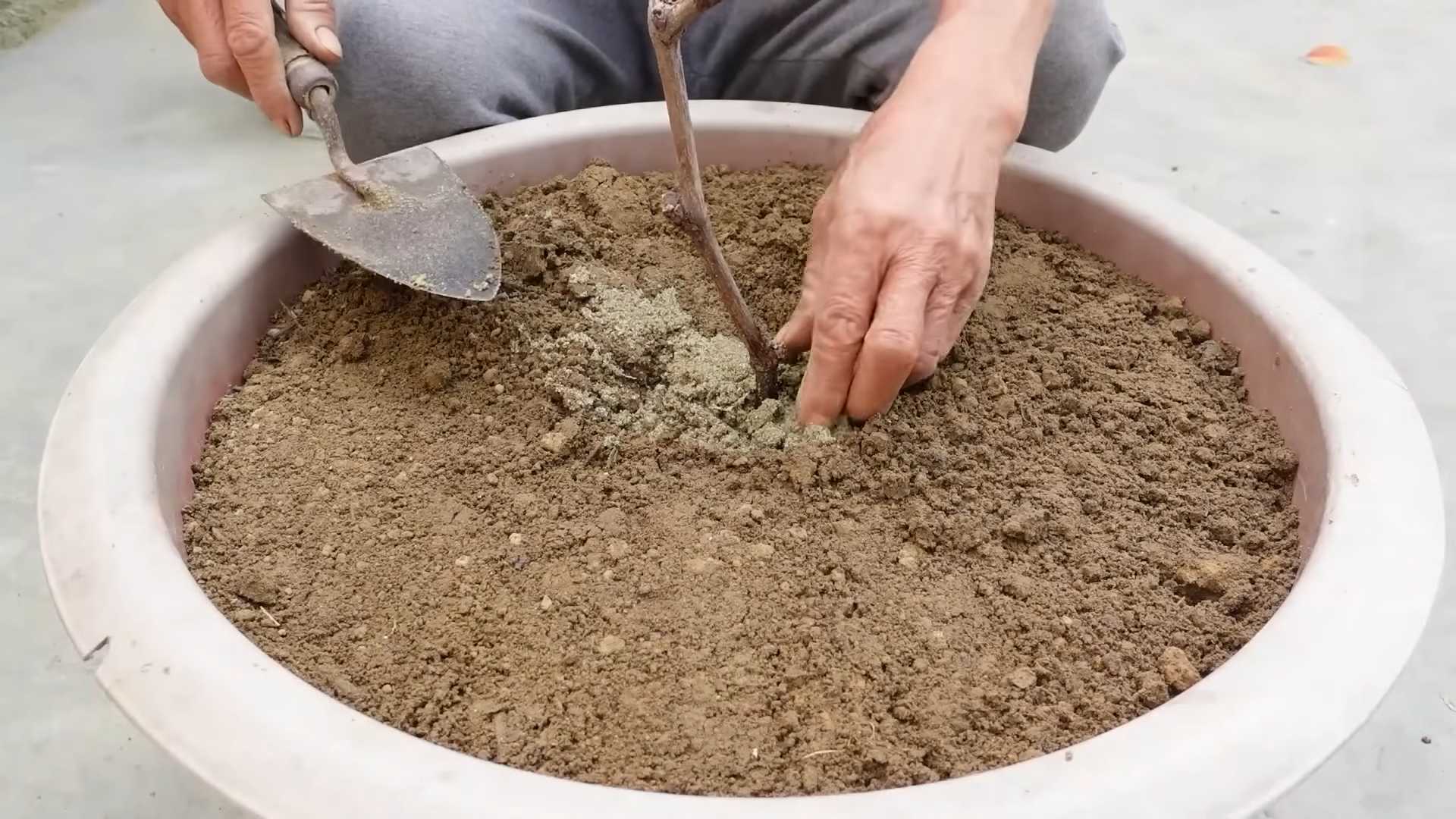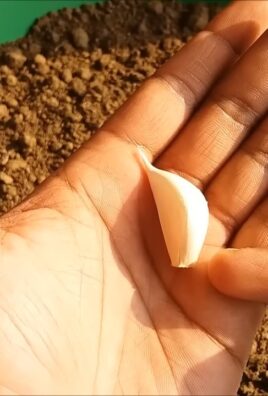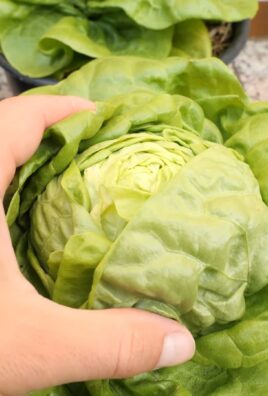Grow Your Own Grapes and transform your backyard into a personal vineyard! Imagine plucking juicy, sun-ripened grapes straight from the vine, ready to be enjoyed as a healthy snack, pressed into homemade juice, or even fermented into your own signature wine. Sounds idyllic, right? For centuries, cultivating grapes has been a cherished tradition, dating back to ancient civilizations like the Egyptians and Romans, who revered the fruit not only for its deliciousness but also for its symbolic representation of abundance and prosperity.
But let’s be honest, the thought of growing grapes can seem intimidating. Visions of sprawling vineyards and complex pruning techniques might flash before your eyes. That’s where this DIY guide comes in! I’m here to demystify the process and show you that you don’t need acres of land or a degree in horticulture to successfully grow your own grapes. Whether you have a small balcony, a sunny patio, or a dedicated garden bed, I’ll share simple, effective tricks and hacks that will empower you to cultivate your own thriving grapevine.
In today’s world, where we’re increasingly conscious of where our food comes from and eager to embrace sustainable practices, growing your own grapes is more relevant than ever. Not only will you enjoy the unparalleled flavor of homegrown fruit, but you’ll also reduce your carbon footprint, save money, and experience the immense satisfaction of nurturing a plant from vine to table. So, grab your gardening gloves, and let’s embark on this exciting journey together!

Grow Your Own Grapes: A Beginner’s Guide to Vineyard Dreams
So, you’re thinking about growing your own grapes? That’s fantastic! It might seem daunting, but trust me, with a little planning and effort, you can be enjoying homegrown grapes in a few years. I’m going to walk you through everything you need to know, from choosing the right variety to harvesting your delicious bounty. Let’s get started!
Choosing the Right Grape Variety
This is arguably the most important step. You can’t just pick any grape and expect it to thrive in your backyard. You need to consider your climate, soil, and what you want to use the grapes for (eating, juice, wine).
* Climate Considerations: Grapes are generally categorized as European (Vitis vinifera), American (Vitis labrusca), or French-American hybrids. European grapes are known for their superior wine quality but are more susceptible to diseases and require warmer climates. American grapes are hardier and more disease-resistant, making them a good choice for colder regions. French-American hybrids offer a balance of both.
* Hardiness Zones: Check your USDA hardiness zone to determine which varieties will survive your winters.
* Growing Season Length: Make sure the variety you choose has enough time to ripen in your growing season.
* Soil Type: Grapes prefer well-drained soil with a slightly acidic to neutral pH (6.0-7.0).
* Intended Use:
* Table Grapes: Choose varieties known for their sweetness, large size, and thin skins, like Thompson Seedless, Concord (American), or Canadice (seedless hybrid).
* Wine Grapes: Research varieties suitable for your climate and the type of wine you want to make. Popular choices include Cabernet Sauvignon, Merlot, Chardonnay, and Riesling.
* Juice Grapes: Concord is a classic choice for juice, but other varieties like Niagara also work well.
I highly recommend contacting your local agricultural extension office. They can provide specific recommendations for grape varieties that thrive in your area and offer valuable advice on local growing conditions.
Preparing the Planting Site
Grapes need plenty of sunlight and well-drained soil. Proper site preparation is crucial for their long-term health and productivity.
* Sunlight: Choose a location that receives at least 6-8 hours of direct sunlight per day.
* Soil Drainage: Grapes hate “wet feet.” If your soil is heavy clay, amend it with organic matter like compost, well-rotted manure, or peat moss to improve drainage. You can also consider planting on raised beds.
* Soil Testing: A soil test will tell you the pH and nutrient levels of your soil. This will help you determine if you need to add any amendments before planting. You can usually get a soil test done through your local agricultural extension office.
* Weed Control: Eliminate all weeds and grass from the planting area. This will reduce competition for water and nutrients. You can use herbicides, but I prefer to use a combination of hand-weeding and mulching.
Planting Your Grape Vines
Now for the fun part! Planting your grape vines is an exciting step towards your own vineyard.
1. Timing: The best time to plant grape vines is in early spring, after the last frost.
2. Spacing: Space grape vines according to the variety and training system you plan to use. Generally, table grapes are spaced 8-10 feet apart in rows that are 10-12 feet apart. Wine grapes are often spaced closer together.
3. Digging the Hole: Dig a hole that is twice as wide as the root ball and just as deep.
4. Planting the Vine: Gently remove the grape vine from its container and loosen the roots. Place the vine in the hole, making sure the top of the root ball is level with the surrounding soil.
5. Backfilling: Backfill the hole with soil, gently tamping it down to remove air pockets.
6. Watering: Water the newly planted vine thoroughly.
7. Mulching: Apply a layer of mulch around the base of the vine to help retain moisture, suppress weeds, and regulate soil temperature.
Training and Pruning Your Grape Vines
Training and pruning are essential for shaping the vine, maximizing fruit production, and maintaining its health. This is where things can get a little technical, but don’t worry, I’ll break it down.
Understanding Grapevine Anatomy
Before we dive into training and pruning, it’s helpful to understand the basic parts of a grapevine:
* Trunk: The main vertical stem of the vine.
* Cordons: Permanent horizontal arms that extend from the trunk.
* Spurs: Short, stubby branches that grow from the cordons and produce fruit.
* Canes: One-year-old shoots that grow from the spurs.
* Buds: The dormant growing points on the canes. Fruit is produced from buds on one-year-old wood.
Choosing a Training System
There are several different training systems for grape vines, each with its own advantages and disadvantages. Some common systems include:
* Cane Pruning: This system involves selecting a few strong canes each year and pruning away the rest. It’s often used for varieties that produce fruit on buds located further out on the cane.
* Spur Pruning: This system involves pruning the canes back to short spurs, which will produce fruit in the following year. It’s often used for varieties that produce fruit on buds located closer to the base of the cane.
* Head Training: This is a simpler system where the vine is trained to a short trunk and the canes are allowed to grow freely. It’s often used for table grapes.
For beginners, I recommend starting with a simple spur pruning system. It’s relatively easy to learn and maintain.
Pruning Steps (Spur Pruning)
Pruning is best done in late winter or early spring, before the buds begin to swell.
1. Remove Dead, Diseased, or Damaged Wood: Start by removing any wood that is dead, diseased, or damaged.
2. Select Cordons: Choose two strong, healthy canes to become your cordons. These should be growing horizontally along the trellis wire.
3. Prune the Cordons: Prune the cordons back to the desired length, typically 3-4 feet.
4. Select Spurs: Choose spurs that are spaced evenly along the cordons, about 6-8 inches apart.
5. Prune the Spurs: Prune the spurs back to 2-3 buds each.
6. Remove Excess Canes: Remove all other canes that are not being used as cordons or spurs.
Don’t be afraid to prune hard! Grapes are vigorous growers, and pruning encourages new growth and fruit production.
Training Steps
Training involves guiding the growth of the vine to create the desired shape.
1. First Year: Focus on establishing a strong trunk. Select the strongest shoot and tie it to a stake or trellis wire. Remove all other shoots.
2. Second Year: Train the selected shoot to the top of the trellis wire. Once it reaches the top, pinch off the growing tip to encourage lateral growth.
3. Third Year: Select two strong lateral shoots to become the cordons. Train them horizontally along the trellis wire.
4. Subsequent Years: Continue to train the vine according to the chosen training system.
Watering and Fertilizing
Grapes need consistent watering, especially during dry periods. Fertilizing can help to promote healthy growth and fruit production.
* Watering: Water deeply and regularly, especially during the first few years. Avoid overwatering, which can lead to root rot.
* Fertilizing: Fertilize in early spring with a balanced fertilizer, such as 10-10-10. Follow the instructions on the fertilizer label. You can also use organic fertilizers like compost or well-rotted manure.
* Monitor Nutrient Levels: A soil test can help you determine if your grapes are getting the nutrients they need.
Pest and Disease Control
Grapes are susceptible to a variety of pests and diseases. Regular monitoring and preventative measures can help to keep your vines healthy.
* Common Pests: Grape phylloxera, Japanese beetles, grape berry moth, and spider mites.
* Common Diseases: Powdery mildew, downy mildew, black rot, and Botrytis bunch rot.
* Prevention:
* Choose Disease-Resistant Varieties: This is the best way to prevent disease problems.
* Provide Good Air Circulation: Prune your vines to allow for good air circulation, which will help to prevent fungal diseases.
* Keep the Area Clean:

Conclusion
So, there you have it – a comprehensive guide to successfully growing your own grapes! We’ve covered everything from selecting the right variety for your climate and space to preparing the soil, planting, training, pruning, and protecting your precious vines from pests and diseases. It might seem like a lot at first, but trust us, the reward of harvesting your own juicy, sun-ripened grapes is well worth the effort.
Why is this DIY grape-growing adventure a must-try? Because it’s more than just growing fruit; it’s about connecting with nature, understanding the cycles of the seasons, and experiencing the satisfaction of nurturing something from a tiny seedling to a bountiful vine. Imagine the joy of sharing your homegrown grapes with friends and family, knowing that you cultivated them with your own hands. Plus, you’ll have complete control over the growing process, ensuring that your grapes are free from harmful pesticides and chemicals.
But the benefits don’t stop there. Growing your own grapes allows you to experiment with different varieties and techniques. Perhaps you’ll discover a new favorite grape for winemaking, or maybe you’ll perfect a unique trellis system that maximizes your yield. The possibilities are endless!
Consider these variations to personalize your grape-growing experience:
* Vertical Shoot Positioning (VSP): This training method is ideal for maximizing sunlight exposure and air circulation, leading to healthier vines and better fruit quality.
* Head Training: A simpler method suitable for smaller spaces, where the vine is trained to a single trunk with short arms.
* Arbor Training: Create a stunning and functional arbor by training your grapevines overhead, providing shade and beauty.
* Container Growing: If you have limited space, you can successfully grow grapes in large containers, allowing you to enjoy fresh grapes even on a balcony or patio. Choose dwarf or compact varieties for best results.
Don’t be afraid to experiment with different grape varieties, too. Try a classic Cabernet Sauvignon for winemaking, a sweet Thompson Seedless for snacking, or a unique Concord grape for making delicious juice and jelly. The key is to choose varieties that are well-suited to your local climate and growing conditions.
We understand that growing grapes can seem daunting, but with a little patience, dedication, and the right information, you can achieve success. Remember to start small, learn from your mistakes, and most importantly, enjoy the process.
We wholeheartedly encourage you to embark on this rewarding journey of growing your own grapes. We are confident that you will be amazed by the results. Once you’ve harvested your first crop, we’d love to hear about your experience! Share your photos, tips, and stories with us in the comments below. Let’s create a community of grape-growing enthusiasts and inspire others to discover the joy of homegrown goodness. So, grab your gardening gloves, choose your favorite grape variety, and get ready to experience the magic of growing your own grapes!
Frequently Asked Questions (FAQ)
What is the best time of year to plant grapevines?
The best time to plant grapevines is typically in the early spring or late fall, when the vines are dormant. This allows the roots to establish themselves before the growing season begins. In areas with harsh winters, spring planting is generally preferred to avoid potential frost damage to newly planted vines. Fall planting is suitable for regions with milder winters.
How much space do grapevines need?
The amount of space required for grapevines depends on the variety and the training system used. In general, allow at least 8-10 feet between vines in a row and 10-12 feet between rows. For container-grown grapes, choose a large container that is at least 20 gallons in size. Dwarf or compact varieties are best suited for container growing.
What type of soil is best for growing grapes?
Grapes prefer well-drained soil with a slightly acidic to neutral pH (6.0-7.0). The soil should be rich in organic matter and have good drainage to prevent root rot. Before planting, amend the soil with compost or other organic materials to improve its fertility and drainage. Avoid heavy clay soils that retain too much moisture.
How often should I water my grapevines?
Newly planted grapevines should be watered regularly to keep the soil consistently moist but not waterlogged. Once established, grapevines are relatively drought-tolerant and do not require frequent watering. Water deeply but infrequently, allowing the soil to dry out slightly between waterings. During periods of drought or extreme heat, increase the frequency of watering.
How do I prune grapevines?
Pruning is essential for maintaining the health and productivity of grapevines. The best time to prune is in late winter or early spring, before the buds begin to swell. Remove any dead, damaged, or diseased wood. Prune back the previous year’s growth to leave only a few buds on each spur. The specific pruning technique will depend on the training system used.
What are some common pests and diseases that affect grapevines?
Common pests that affect grapevines include aphids, spider mites, Japanese beetles, and grape phylloxera. Common diseases include powdery mildew, downy mildew, black rot, and Botrytis bunch rot. Monitor your vines regularly for signs of pests or diseases and take appropriate action to control them. Organic pest control methods include using insecticidal soap, neem oil, and beneficial insects. Fungicides can be used to control fungal diseases.
How long does it take for grapevines to produce fruit?
Grapevines typically take 2-3 years to begin producing fruit. The first year, the vines will focus on establishing their root system. In the second year, they may produce a small crop of grapes. By the third year, they should be producing a more substantial crop. The full potential of the vine is usually reached in 5-7 years.
Can I grow grapes in containers?
Yes, you can successfully grow grapes in containers, especially if you have limited space. Choose a large container that is at least 20 gallons in size and has good drainage. Select dwarf or compact grape varieties that are well-suited for container growing. Use a well-draining potting mix and fertilize regularly. Provide adequate sunlight and support for the vines to climb.
How do I protect my grapes from birds and other animals?
Birds and other animals can be a major nuisance when growing grapes. To protect your grapes, you can use netting to cover the vines. You can also use bird repellents or scarecrows to deter birds. Fencing can be used to keep out larger animals such as deer.
What are some tips for getting the best flavor from my homegrown grapes?
To get the best flavor from your homegrown grapes, ensure that they receive plenty of sunlight and water. Monitor the sugar levels in the grapes as they ripen and harvest them when they reach the desired sweetness. Avoid overwatering the vines as this can dilute the flavor of the grapes. Proper pruning and training will also help to improve the flavor and quality of the grapes. Remember, growing your own grapes is a journey, and each year you’ll learn more about what works best for your specific environment and grape variety. Enjoy the process and the delicious rewards!




Leave a Comment